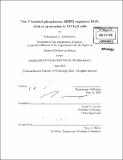| dc.contributor.advisor | Frank B. Gertler. | en_US |
| dc.contributor.author | Kuhlmann, Georgiana L. (Georgiana Louise) | en_US |
| dc.contributor.other | Massachusetts Institute of Technology. Dept. of Biology. | en_US |
| dc.date.accessioned | 2010-09-02T17:25:30Z | |
| dc.date.available | 2010-09-02T17:25:30Z | |
| dc.date.copyright | 2010 | en_US |
| dc.date.issued | 2010 | en_US |
| dc.identifier.uri | http://hdl.handle.net/1721.1/58294 | |
| dc.description | Thesis (S.M.)--Massachusetts Institute of Technology, Dept. of Biology, 2010. | en_US |
| dc.description | Cataloged from PDF version of thesis. | en_US |
| dc.description | Includes bibliographical references (p. 47-57). | en_US |
| dc.description.abstract | In metastatic cancer, cells must be able to migrate from their original environment, move through the blood or lymphatic system, and colonize a distant organ. Mena, a member of the Ena/VASP family of proteins, is upregulated in invasive populations of breast cancer cells. The Ena/VASP (enabled/vasodilator-stimulated phosphoprotein) family of proteins regulate both the geometry and dynamics of actin filament networks. Mena specifically is alternatively spliced with an invasive isoform, MenaINV, upregulated in metastastic cells, while an epithelial isoform, Menalla, is downregulated. SH2- domain containing 5-inositol phosphatase (SHIP2) interacts with Mena and is thought to play a role in breast cancer. SHIP2 is a 5-phosphatase that catalyzes the dephosphorylation of phosphatidylinositol 3,4,5-trisphosphate (PI(3,4,5)P 3) to phosphatidylinositol 3,4-bisphosphate (PI(3,4)P2) as well as the dephosphorylation of phosphatidylinositol 4,5- bisphosphate (PI(4,5)P 2). PI(3,4,5)P 3 and P][(4,5)P 2 are two major phosphoinositides at the plasma membrane and regulate a variety of cellular functions, including receptor signaling, membrane-cytoskeleton interactions and clathrin-mediated endocytosis. Here I have looked at the effects of knocking down SHIP2 in the MTLn3 cell line, a metastatic rat breast carcinoma line. I found that when SHIP2 is knocked down in cells, there is an increase in membrane protrusion upon stimulation with EGF, and that recruitment of Mena to the leading edge is enhanced, implying that this increase in protrusion may be due to a change in Mena localization. | en_US |
| dc.description.statementofresponsibility | by Georgiana L. Kuhlmann. | en_US |
| dc.format.extent | 57 p. | en_US |
| dc.language.iso | eng | en_US |
| dc.publisher | Massachusetts Institute of Technology | en_US |
| dc.rights | M.I.T. theses are protected by
copyright. They may be viewed from this source for any purpose, but
reproduction or distribution in any format is prohibited without written
permission. See provided URL for inquiries about permission. | en_US |
| dc.rights.uri | http://dspace.mit.edu/handle/1721.1/7582 | en_US |
| dc.subject | Biology. | en_US |
| dc.title | The 5' inositol phosphatase SHIP2 regulates EGF-elicited protrusion in MTLn3 cells | en_US |
| dc.title.alternative | Effects of SHIP2 knockdown in MTLn3 cells | en_US |
| dc.type | Thesis | en_US |
| dc.description.degree | S.M. | en_US |
| dc.contributor.department | Massachusetts Institute of Technology. Department of Biology | |
| dc.identifier.oclc | 654432791 | en_US |
